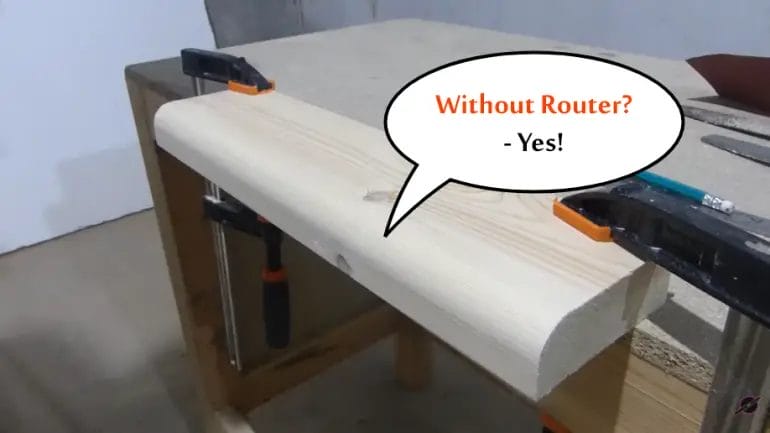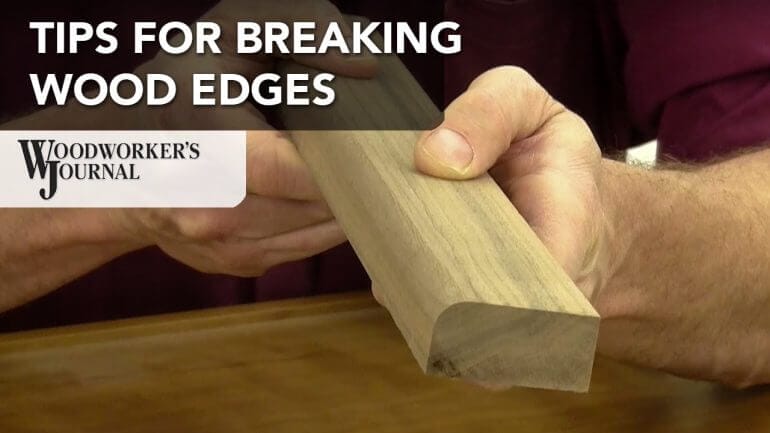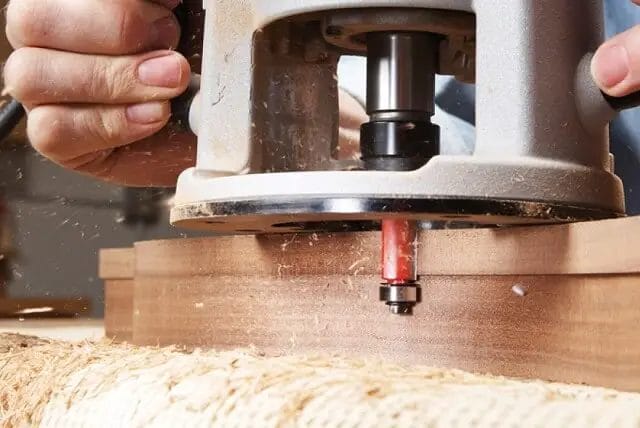Looking to give your wooden projects a sleek and modern touch? Learn how to make round edges on wood with our easy step-by-step guide. Whether you’re a DIY enthusiast or a professional carpenter, this technique will help you achieve smooth, rounded edges that add both style and safety to your creations.
Creating round edges on wood not only enhances the overall aesthetic appeal but also prevents sharp corners that can be potentially hazardous. By following our expert tips and utilizing the right tools, you’ll be able to achieve flawless, curved edges that will make your woodworking projects stand out.

From selecting the right router bit to mastering the technique of proper sanding, our comprehensive guide will walk you through each stage of the process. Discover the secrets to creating perfectly rounded edges that add a professional finish to your furniture, trim, and other wooden projects.
With our easy-to-follow instructions and helpful tips, you’ll soon be able to transform your wooden creations and take your woodworking skills to the next level. Don’t miss out on this essential technique that will elevate the quality and appearance of your woodwork – start making round edges on wood today!

Tools and Techniques for Creating Rounded Wood Edges
Creating rounded wood edges can add a beautiful touch to your woodworking projects. Whether you’re making a table, a shelf, or a picture frame, rounded edges can give your piece a more polished and professional look. In this section, we will explore some of the essential tools and techniques you can use to achieve perfectly rounded wood edges.
1. Router
A router is one of the most versatile tools for creating rounded wood edges. It is a power tool that uses a high-speed rotating bit to remove material from the wood. With the right router bit, you can easily create various profiles and curves on the edges of your wood pieces. There are two main types of router bits that can be used for rounding edges: round-over bits and ogee bits.
Round-over bits are commonly used for creating a simple rounded edge. They have a curved cutting edge that gradually rounds off the sharp edges of the wood. On the other hand, ogee bits create a more decorative profile with a concave shape followed by a convex shape. The choice between round-over and ogee bits depends on the desired effect you want to achieve.
2. Sandpaper
Sanding is an important step in achieving smooth and rounded wood edges. After using a router or other shaping tools, sandpaper helps to refine the shape and remove any roughness on the edge. Start with a coarse-grit sandpaper to remove any tool marks or imperfections, and gradually move up to finer-grit sandpaper to achieve a smooth finish.
When sanding the edges, it’s important to sand evenly and consistently along the entire length of the edge. This will help to create a uniform curve and avoid any unevenness. You can also use a sanding block or a sanding sponge to maintain a flat and even surface while sanding.
3. Spokeshave
A spokeshave is a hand tool that is used to shape and smooth wood surfaces. It consists of a blade mounted between two handles, allowing you to shave off thin layers of wood. This tool is particularly useful for creating rounded edges on curved or irregularly shaped pieces of wood.
To use a spokeshave, hold it at a slight angle to the wood surface and push it across the edge. Move in the direction of the grain to avoid tear-out or splintering. Start with light, controlled strokes and gradually increase the pressure until you achieve the desired shape. Remember to keep the blade sharp and properly adjusted for optimal performance.
4. Hand Plane
A hand plane is another traditional tool for shaping and smoothing wood surfaces. It consists of a sharp blade that protrudes through a flat base, allowing you to remove thin shavings of wood. While a hand plane may take more practice and skill to use effectively, it can produce excellent results when creating rounded wood edges.
To use a hand plane, position the plane at a slight angle to the wood surface and push it along the edge. Apply even pressure and make multiple passes to gradually shape the edge. As with the spokeshave, it’s important to work in the direction of the grain to prevent tear-out. Regular sharpening and proper adjustment of the blade are essential for achieving clean and smooth cuts.
5. Chisels
Chisels are versatile hand tools that can be used for a variety of woodworking tasks, including creating rounded wood edges. With a sharp chisel, you can remove small amounts of wood to shape and refine the edges. Chisels are particularly useful for creating detailed rounded profiles and for cleaning up any irregularities left by other tools.
To use a chisel for rounding edges, position the chisel at an angle and push it across the edge while applying controlled pressure. Work in small increments and make sure to keep the chisel sharp to avoid tearing or splintering the wood. Take your time and test the edge regularly to ensure the desired shape is achieved.
Summary
Creating rounded wood edges can enhance the overall look and feel of your woodworking projects. By utilizing tools such as routers, sandpaper, spokeshaves, hand planes, and chisels, you can achieve smooth and perfectly rounded wood edges. Remember to practice proper safety precautions when using power tools and always work with precision and attention to detail. With the right tools and techniques, you can take your woodworking skills to the next level and create beautiful pieces with rounded wood edges.

Benefits of Adding Rounded Edges to Woodwork
When it comes to woodworking, the finishing touches can make a significant difference in the overall aesthetic appeal and functionality of the final piece. One design element that is often overlooked but can greatly enhance the look and feel of woodwork is adding rounded edges. In this section, we will explore the various benefits of incorporating rounded edges into your woodworking projects.
1. Improved Safety
One of the main advantages of rounded edges is the increased safety they provide. Sharp corners and edges on furniture or other wooden objects can pose a potential hazard, especially in households with children or pets. By rounding off the edges, you eliminate the risk of painful accidents or injuries when bumping into or brushing against the woodwork.
2. Enhanced Ergonomics
Another benefit of adding rounded edges is improved ergonomic comfort. When using furniture or other wooden items that come in contact with the body, such as chairs or tabletops, rounded edges create a more comfortable and ergonomic experience. The smooth curves distribute pressure evenly, reducing discomfort caused by sharp corners digging into the skin or body.
3. Visual Appeal
Rounded edges can significantly enhance the visual appeal of woodwork. The soft curves create a more organic and inviting look compared to sharp-edged designs. This aesthetic appeal is particularly relevant in contemporary or modern interior design styles where clean lines and fluid shapes are favored. Rounded edges can give your woodworking projects a contemporary touch while maintaining a timeless elegance.
4. Increased Durability
Wooden edges that are left sharp and exposed are more prone to damage, chipping, or splintering over time. By rounding off the edges, you can increase the durability and longevity of the woodwork. The rounded edges act as a protective barrier, reducing the likelihood of chips or splinters forming and ensuring the wood remains in good condition for longer periods.
5. Easier Maintenance
Rounded edges are also easier to clean and maintain. Unlike sharp corners that tend to accumulate dust, dirt, or grime, rounded edges are more accessible for cleaning. You can easily wipe down the surfaces without having to worry about hard-to-reach corners or edges. This makes maintenance simpler and ensures that your woodwork stays looking its best with minimal effort.
6. Versatile Design Element
The beauty of rounded edges is their versatility. Whether you are working on a small decorative piece or a large furniture item, rounded edges can be incorporated seamlessly into various designs. They can soften the overall look, add subtle curves, or even create a focal point within the woodwork. This versatility allows you to explore different design possibilities and create unique and customized pieces.
7. Accessibility and Inclusivity
Rounded edges also contribute to making woodwork more accessible and inclusive. Sharp corners can be a challenge for individuals with mobility limitations or those who use mobility aids such as walkers or wheelchairs. By incorporating rounded edges, you create a more inclusive environment where everyone can comfortably navigate and interact with your woodwork.
Summary
Adding rounded edges to woodwork offers several benefits, including improved safety, enhanced ergonomics, visual appeal, increased durability, easier maintenance, versatility in design, and accessibility. By considering and incorporating rounded edges into your woodworking projects, you can elevate the overall quality and aesthetics of your creations while ensuring a safer and more comfortable experience for users.

Creative Designs Using Rounded Edges on Wooden Furniture
In this section, we will explore the creative designs that can be achieved by incorporating rounded edges on wooden furniture. Rounded edges not only add aesthetic appeal to the furniture but also have practical benefits. Let’s dive into some fascinating design ideas:
1. Curved Tabletops
One of the most popular ways to incorporate rounded edges is by using curved tabletops in wooden furniture. Curved edges provide a softer and more organic look to the furniture, making it visually appealing. A round or oval-shaped tabletop can be used for dining tables, coffee tables, or even side tables. This design adds a touch of elegance and sophistication to any room.
2. Smooth Rounded Corners
Instead of traditional sharp corners, incorporating smooth rounded corners in wooden furniture can create a harmonious and safe environment. This design is especially suitable for furniture pieces in homes with young children or pets. Rounded corners not only reduce the risk of injury but also bring a sense of tranquility and relaxation to the space.
3. Rounded Chair Backrests
Adding rounded edges to the backrests of chairs can transform the overall look and comfort of the furniture. The curves provide excellent lumbar support and make sitting for extended periods more enjoyable. Whether it’s a dining chair, lounge chair, or office chair, incorporating rounded backrests adds a touch of elegance and ergonomic functionality.
4. Curved Drawer Fronts
For dressers, cabinets, or bedside tables, incorporating curved drawer fronts is a unique design choice. This rounded edge design not only adds visual interest but also makes opening and closing drawers smoother. It gives a modern and sophisticated look to the furniture piece, making it a focal point in any room.
5. Rounded Bed Headboards
To create a cozy and inviting atmosphere in the bedroom, consider using rounded edges on bed headboards. The curves provide a softer and more welcoming look, enhancing the overall comfort of the space. A rounded headboard can be upholstered or crafted from wood, adding a touch of elegance and luxury to the bedroom décor.
6. Circular Shelving Units
If you’re looking for a unique way to display your favorite items or create additional storage, consider incorporating circular shelving units with rounded edges. Circular shelves not only provide an eye-catching display but also maximize the use of space. The curved edges add a modern and artistic touch, making it a focal point in any room.
7. Rounded Armrests
When it comes to sofas, loveseats, or armchairs, rounded armrests can make a significant difference in both comfort and style. The smooth curves provide a comfortable place to rest your arms, enhancing the overall relaxation experience. From classic designs to contemporary styles, rounded armrests add a touch of sophistication to any seating arrangement.
8. Curved Bookshelves
For book enthusiasts or anyone looking to add a unique element to their home décor, curved bookshelves with rounded edges can be a perfect choice. The curved design not only adds visual interest but also creates a flowing and organic feel to the space. It allows for a creative arrangement of books and accessories, making it an attractive focal point in any room.
In summary, incorporating rounded edges into wooden furniture can elevate the design aesthetic and functionality of any space. From curved tabletops to rounded armrests, there are numerous creative design ideas to explore. Whether you prefer a modern or traditional style, rounded edges provide a unique and visually appealing touch to wooden furniture.
Expert Tips for Achieving Perfectly Rounded Wood Edges
When working with wood, achieving perfectly rounded edges can elevate the overall appearance and quality of your project. Whether you are a beginner or an experienced woodworker, these expert tips will help you achieve the desired results.
1. Use the Right Tools
The first step in achieving perfectly rounded wood edges is to use the right tools. A router with a round-over bit is the most commonly used tool for this purpose. The size of the round-over bit will determine the radius of the rounded edge. Additionally, a chisel and sandpaper can be used to refine and smooth the edges.
2. Start with the Right Wood
Not all wood types are suitable for achieving perfectly rounded edges. Softer woods such as pine or cedar are easier to work with and tend to round over more smoothly. Hardwoods like oak or maple may require more effort and precision to achieve a smooth round edge.
3. Mark the Edge
Before you start rounding the edges, it is essential to mark the areas that need to be rounded. Use a pencil or a marking gauge to clearly indicate the boundaries of the rounded edge. This will help you maintain consistency and avoid any mistakes during the process.
4. Start Slowly
When using a router, it is important to start slowly and gradually increase the speed as you become more comfortable and confident. Rushing through the process can lead to mistakes or uneven edges. Take your time and focus on maintaining a steady and controlled movement.
5. Secure the Wood
Securing the wood piece firmly in place is crucial to achieving perfectly rounded edges. Use clamps or a vise to hold the wood securely, minimizing any movement or vibrations. This will ensure that the router or other tools can work smoothly and accurately.
6. Practice on Scrap Wood
If you are new to rounding wood edges or using a particular tool, it is always a good idea to practice on scrap wood before working on your actual project. This will allow you to get a feel for the tool and technique, and make any necessary adjustments before proceeding.
7. Take Breaks and Evaluate
During the process of rounding wood edges, it is important to take breaks and evaluate your work. Step back and examine the rounded edges from different angles to ensure they are uniform and smooth. Making adjustments and refinements along the way will help you achieve the best results.
8. Sand and Finish
Once you have achieved the desired rounded edges, it is important to sand and finish the wood surface for a polished look. Start with a coarse grit sandpaper and gradually move to finer grits for a smooth finish. Apply a wood finish or paint as per your project requirements.
9. Safety First
Lastly, always prioritize safety when working with wood and power tools. Wear appropriate safety gear such as safety glasses, gloves, and a dust mask. Familiarize yourself with the safety precautions for each tool you use and follow them diligently.
In summary, achieving perfectly rounded wood edges requires the right tools, proper technique, and attention to detail. By following these expert tips, you can enhance the appearance and quality of your woodworking projects. Remember to practice on scrap wood, take breaks to evaluate your work, and prioritize safety throughout the process.
FAQs
1. How can I make round edges on wood?
To make round edges on wood, you can use a router with a roundover bit. Set the depth of the bit and guide the router along the edges of the wood. Alternatively, you can use sandpaper or a file to manually shape the edges into a rounded form.
2. What tools do I need to make round edges on wood?
You will need a router with a roundover bit, a router table (optional), sandpaper, and a file. If you are using a router, make sure to also have a guide or fence to help keep the edges uniform.
3. Are there any safety precautions I should take when making round edges on wood?
Yes, it is important to wear safety goggles and ear protection when using power tools such as a router. Make sure to secure the wood properly before working on it, and always follow the manufacturer’s instructions for the tools you are using.
Conclusion
In conclusion, achieving round edges on wood can add a touch of elegance and safety to your woodworking projects. By following the right techniques and tools, you can effortlessly create smooth and professionally finished edges. Whether you choose to use a router with a roundover bit or sand the edges using sandpaper or a sanding block, the key is to take your time and maintain a steady hand. Remember to always wear proper safety gear and work in a well-ventilated area. With practice and patience, you’ll soon master the art of creating beautiful round edges on your wooden creations.